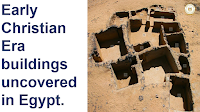The Endangered Archaeology in the MiddleEast and North Africa Project systematically analyses open-source satellite imagery through platforms such as Google Earth to identify and document the form and condition of archaeological sites. While surveying an area of the Jordan-Saudi Arabia border region, a slight rectangular trace, consistent with a Roman fort of camp, was identified, with further investigations revealing two more similar traces, to the west of the original site. These sites conform closely to that produced by Roman military activities, with a rectangular shape, symmetrical entrances, and titulus outworks in front of the entrances. These sites were surveyed by the Aerial Archaeology in Jordan Project in November 2022.
In a paper published in the journal Antiquity on 27 April 2023, Michael Fradley, Andrew Wilson, Bill Finlayson, and Robert Bewley of the School of Archaeology at the University of Oxford, describe these structures, and discuss their possible origins.
The Western Camp, identified as EAMENA-0216152, is about 43.5 km to the southeast of Bayir Castle (which may also be of Roman origin) in eastern Jordan. It is rectangular, measuring roughly 125 by 105 m, with aerial photographs showing some possible internal divisions.
The Central Camp, EAMENA-0216151, is about 44.2 km to the southeast of the Western Camp. This camp is smaller, measuring about 95 by 65 m, with internal divisions again visible in aerial photographs.
The Eastern Camp lies about 37.7 km to the southeast of the Central Camp, and is about the same size.
The Western Camp has previously been identified on the MEGA-Jordan platform, a GIS inventory of archaeological sites in Jordan, but not identified as a Roman site, while neither the Central nor Eastern camps have previously been detected. All three sites appear relatively stable, but are affected by vehicle tracks. The forts are located on limestone and chalk formations to the west of Wadi Sirhan, while Bayir Castle is located on limestones of the Belqa Broup of central Jordan. There are no signs of other structures of any kind close to the forts, suggesting that the landscape has been uninhabited for millennia. The area to the south of Wadi Sirhan was also examined, with no signs of further structures being detected.
This group of camps provides rare insight into Roman military activity in northern Arabia, an area where little is known about Roman activity, with only four similar camps previously identified; one at Azaima to the north of the Dead Sea, two at Tell Abara, near Udruh, and Kh. Abu Safat to the southwest of Bayir Castle, and a possible site at Azraq, which is overlain by a later fortification.
The line along which these camps are organized suggests that the Romans who built them may have been taking part in an expedition against Dûmat al-Jandal and Sakaka in the Jawf Region in the eastern part of the Nabataean Kingdom. It has previously been suggested that Dûmat al-Jandal could have been reached by a caravan route following approximately the same path, and it is possible that a Roman army might have followed such a caravan route in order to bypass the Wadi Sirhan route, and launch a surprise attack on the Jawf Region, or more simply as a flanking manoeuvre, in support of a force taking the more obvious route.
The distance between the camps is more than an infantry unit could easily cross in a day, making it likely that these camps were used by mounted troops, possibly even using Camels. The Western Camp would potentially have been large enough to hold two cohorts of such mounted soldiers, while the Central and Eastern camps could probably only hold one.
This reduction in size as the force moved to the east raises the possibility that half the troops were lost before reaching the Central Camp, although Fradley et al. believe it is more likely that the Western Camp is a single days ride from the wells at Bayir Castle, and that extra troops were stationed here to help ferry water to the advancing units, who would not be able to resupply until reaching Wadi Sirhan. Another alternative is that the force split in two after leaving the Western Camp, and the route taken by the other part has not been found.
The Nabataean Kingdom is known to have been attacked by a Roman army led by Marcus Aemilius Scaurus in 62 BC, although the historical writings concentrate on the fighting around Petra far to the west of the newly discovered camps. The kingdom was eventually annexed by Rome in 106 AD bu the Emperor Trajan, and the camps may date from this campaign, suggesting that there was more violent conflict involved in the annexation than has previously been thought. The Roman army is known to have been present at Hegra by 175 AD, and Dûmat al-Jandal by the third century, although it is unclear why such a force would have needed temporary desert camps, making it likely the camps were used during Trajan's campaign in the region.
See also...
Follow Sciency Thoughts on Facebook.
Follow Sciency Thoughts on Twitter.












